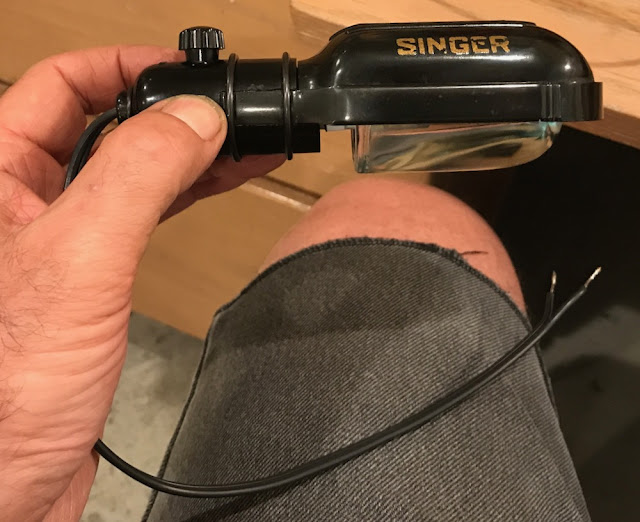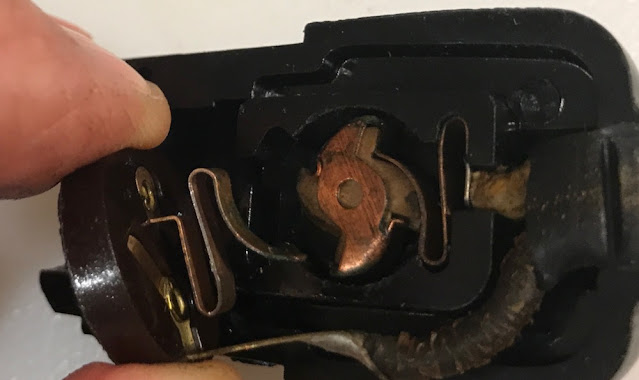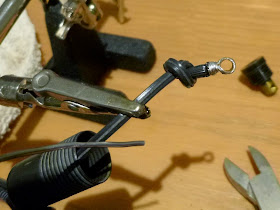I always rewire the Singer light fixture when rewiring the motor. Fifty to eighty year old wiring is all ready to be replaced.
I'm also having great luck with the LED replacement lamp (no heat, long life, more light).
Supplies Needed:

Solder
Flux
Soldering Iron
Desoldering Tool
18 gauge 18/2 SPT-1 wire (lamp cord)
This is the typical receptacle on a 15-91, 201. Note the screw above the three pins.
Unscrew the screw to access the wiring behind the receptacle.
Unscrew the knurled bakelite nuts and remove the wires and one washer (note position 1).
The wire on the right runs to the light fixture, the wire on the left runs to the motor.
Note that the three pins have designation numbers: 1-3.
Remove the decorative round access plate on the rear of the machine to access the light fixture mounting screw. Remove the screw.
Now the light fixture is free from the machine and ready for disassembly and cleaning.
Note the two metal arms anchored to the two metal rings. Slide the lamp hood/glass away from the rings and then remove the hood and glass from the arms.
Be careful, that is a real glass lens and is hard to replace without buying a donor machine. Note how the three pieces are oriented.
The glass cleans very easily with glass cleaner. Use #0000 steel wool to remove the surface rust from the metal reflector.
You may need a thin flat blade screwdriver to open the gap in the rings in order to insert the crimp ring pliers to spread the gap wide enough to remove the metal arms and to remove the rings from the bakelite socket.
The little ring at the end is the hardest. You might need a mini-screwdriver to open the gap. Sometimes you can use a standard flat blade screwdriver against the body of the housing to pry the ring away from the housing and off the end toward the cord.
Gently open the two halves of the housing to expose the switch mechanism. It is a rotary switch that rotates counter-clockwise as you view the photo above. Note the position of the two metal springs (they are different).
Gently slide the left spring and bakelite plate from the housing. It is still connected by one of two wires.
Both halves of the housing and the wire soldered to the springs. Note that the wires are of different lengths. The wires and springs need to fit back into the housing the same way that they came out so cut the new wires as closed to the length of the old wires as possible.
Spray the rotary switch from both sides with tuner cleaner and work the switch before reassembly.
Be sure to clean all of the copper components with #0000 steel wool before proceeding.
Place the wire in a "third hand" and proceed to desolder the wires from the left and right spring. Note that the left side spring will be the hot wire. Now desolder the right side spring which is the neutral wire. It is common in electrical wiring to always switch the hot side of the circuit.
Cut a 12" length of wire. After preparing the wire lengths on one end and stripping the insulation back (just 1/8"), solder the hot wire to the left spring and the neutral wire to the right spring. One of the wires will be ribbed (neutral) and one will be smooth (hot).
Determine the length of wire needed to the machine receptacle and wire according to the diagram provided below. If you are planning on making your own solder terminals, see terminal section below before cutting wires to length.
This was a very worthwhile project and ensures that these beautiful old machines go on sewing for many years to come.
_____________________________________________________________________________
The next section shows the solder terminal technique from another machine.
The process is the same for the 15 series machines or as a replacement for a standard crimp terminal.
I far prefer this process to crimp connectors. It is also as close to the original construction as possible.
Once you've determined the correct length for the overall wire to connect to the machine receptacle, cut and strip the wire allowing for about 2" of uninsulated wire to make the terminals. The excess wire will be trimmed later.
Wrap the wire once around a 3/16" drill bit shank and twist the wire twice around itself. Cut off any remaining wire.
Note: For this machine you will tie a knot in the wire before the terminal. The metal barrels shown are for a Singer 128.
Using solder, tin the loop and the bit of wire back to the insulation.

While the solder is still hot, using smooth jaw pliers, squeeze the tinned wire and loop flat. This will make it easier to screw the loop to the lug.

Using solder, tin the loop and the bit of wire back to the insulation.

While the solder is still hot, using smooth jaw pliers, squeeze the tinned wire and loop flat. This will make it easier to screw the loop to the lug.

Use an awl to round the hole in the newly created terminal.
_______________________________________________________________________________
Vintage Singer sewing machine old style AC plugs were not polarized; consequently the hot side of the circuit can run through either side of the machine. The light socket can provide a shock even with the light switch off depending on how the non-polarized AC plug is inserted into the AC receptacle.

I am providing a wiring diagram that depicts a polarized wiring path using a polarized AC plug.
It might be helpful to also note that polarity does not matter with regard to the controller and the motor.
I hope you have found this useful.
Michael































No comments:
Post a Comment